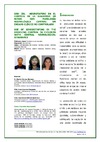Please use this identifier to cite or link to this item:
https://accedacris.ulpgc.es/jspui/handle/10553/71392
| DC Field | Value | Language |
|---|---|---|
| dc.contributor.author | Vílchez Barrera, Martín Eduardo | en_US |
| dc.contributor.author | Lozano Céspedes, Irma | en_US |
| dc.contributor.author | Matias Quintana, Guacimara | en_US |
| dc.date.accessioned | 2020-04-17T09:07:03Z | - |
| dc.date.available | 2020-04-17T09:07:03Z | - |
| dc.date.issued | 2016 | en_US |
| dc.identifier.issn | 1885-527X | en_US |
| dc.identifier.other | Dialnet | - |
| dc.identifier.uri | https://accedacris.ulpgc.es/handle/10553/71392 | - |
| dc.description.abstract | Objetivo: valorar la utilidad del vendaje neuromuscular en el control de la sialorrea en niños con patología neurológica central Métodos se realizó un ensayo clínico sin grupo de control con 12 niños. El tratamiento consistió en la aplicación diaria de una cinta de neurotaping bajo la barbilla durante 3 meses. Las variables utilizadas para el control de este tratamiento fueron valoradas por los padres antes de iniciar el tratamiento, al mes y a los tres meses; utilizando un test que incluyen los ítems frecuencia y severidad del babeo, número de cambio de babero al día, presencia de olor desagradable de baba, problemas en la piel, frecuencia de la necesidad de limpiar la baba, presencia de molestias por el babeo, frecuencia de limpieza de objetos por la baba y probabilidades de aspiración y ahogamiento. Resultados: se obtuvo una mejoría significativa, en los ítems frecuencia del babeo, severidad del babeo, cambio de babero, frecuencia de limpieza de la baba y frecuencia de limpieza de objetos. Conclusiones: se observa evidencia de la utilidad del vendaje neuromuscular en el control de la sialorrea, pero se necesitan más estudios comparativos con mayor potencia estadística y con métodos de valoración más objetivos. | en_US |
| dc.description.abstract | Objective. The goal was to evaluate the usefulness of the Kinesio Taping Method in the drooling control of children with central neurological diseases. Methods. It has been made a clinical trial, without control group, of 12 children. The treatment consisted in a daily application of Kinesio tape, under the chin, for 3 months. The variables used for the control of this treatment were assessed by the own parents before starting this treatment, one month and three months after; using a test that includes items as frequency and severity of drooling, bib and clothing change number per day, presence of unpleasant odor of slime, skin disorders, frequency of the necesity to clean the drool, presence of discomfort due to drooling, object cleaning frequency due to drool and probability of suction and drowning. Results. A significant improvement in items as drooling frequency, drooling severity, bib change, cleaning drool frequency, and cleaning objects frequency was obtained. Conclusions. Evidence of the usefulness of Kinesio Taping in control of salivation is observed, but more comparative studies with greater statistical power and more objective assessment methods are needed.. | en_US |
| dc.language | spa | en_US |
| dc.relation.ispartof | Revista electrónica de terapia ocupacional Galicia, TOG | en_US |
| dc.source | Revista electrónica de terapia ocupacional Galicia, TOG [ISSN 1885-527X], v.13 (23) | en_US |
| dc.subject | 321311 Fisioterapia | en_US |
| dc.subject | 320711 Neuropatología | en_US |
| dc.subject.other | Vendaje neuromuscular | en_US |
| dc.subject.other | Sialorrea | en_US |
| dc.subject.other | Enfermedades neurológicas | en_US |
| dc.title | Uso del neurotaping en el control de la sialorrea en niños con patología neurológica central: un ensayo clínico no controlado | en_US |
| dc.title.alternative | Use of kinesiotaping in the drooling control in children with central neurological disorders | en_US |
| dc.type | info:eu-repo/semantics/Article | en_US |
| dc.type | Article | en_US |
| dc.identifier.url | http://dialnet.unirioja.es/servlet/articulo?codigo=5536317 | - |
| dc.description.lastpage | 0 | - |
| dc.identifier.issue | 23 | - |
| dc.description.firstpage | 5 | - |
| dc.relation.volume | 13 | - |
| dc.investigacion | Ciencias de la Salud | en_US |
| dc.type2 | Artículo | en_US |
| dc.contributor.authordialnetid | 3962588 | - |
| dc.contributor.authordialnetid | No ID | - |
| dc.contributor.authordialnetid | No ID | - |
| dc.identifier.dialnet | 5536317ARTREV | - |
| dc.utils.revision | Sí | en_US |
| dc.identifier.ulpgc | Sí | es |
| dc.description.dialnetimpact | 0,0 | |
| dc.description.dialnetq | Q4 | |
| dc.description.dialnetd | D10 | |
| item.grantfulltext | open | - |
| item.fulltext | Con texto completo | - |
| crisitem.author.dept | Departamento de Ciencias Médicas y Quirúrgicas | - |
| crisitem.author.orcid | 0000-0001-7380-4286 | - |
| crisitem.author.fullName | Vílchez Barrera, Martín Eduardo | - |
| Appears in Collections: | Artículos | |
Page view(s)
205
checked on May 23, 2024
Download(s)
89
checked on May 23, 2024
Google ScholarTM
Check
Share
Export metadata
Items in accedaCRIS are protected by copyright, with all rights reserved, unless otherwise indicated.
